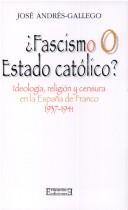| Listing 1 - 10 of 59 | << page >> |
Sort by
|
Book
Abstract | Keywords | Export | Availability | Bookmark
 Loading...
Loading...Choose an application
- Reference Manager
- EndNote
- RefWorks (Direct export to RefWorks)
Book
Year: 2010 Publisher: Köln: Erzbischöfliche Diözesan- und Dombibliothek,
Abstract | Keywords | Export | Availability | Bookmark
 Loading...
Loading...Choose an application
- Reference Manager
- EndNote
- RefWorks (Direct export to RefWorks)
Book
ISBN: 9788816407268 8816407263 Year: 2007 Publisher: Milano: Jaca Book,
Abstract | Keywords | Export | Availability | Bookmark
 Loading...
Loading...Choose an application
- Reference Manager
- EndNote
- RefWorks (Direct export to RefWorks)
Book
ISBN: 9788838238581 8838238588 Year: 2000 Publisher: Roma: Studium,
Abstract | Keywords | Export | Availability | Bookmark
 Loading...
Loading...Choose an application
- Reference Manager
- EndNote
- RefWorks (Direct export to RefWorks)
Student movements --- Church and state --- Fascism and the Catholic Church
Book
Year: 1979 Publisher: Milano : Vita e pensiero,
Abstract | Keywords | Export | Availability | Bookmark
 Loading...
Loading...Choose an application
- Reference Manager
- EndNote
- RefWorks (Direct export to RefWorks)
Catholic Action --- Fascism and the Catholic Church --- Azione cattolica italiana
Book
ISBN: 0812993462 9780679645535 9780812993462 Year: 2014 Publisher: New York Random House
Abstract | Keywords | Export | Availability | Bookmark
 Loading...
Loading...Choose an application
- Reference Manager
- EndNote
- RefWorks (Direct export to RefWorks)
Analyzes the relationship between Pius XI and the notorious Italian dictator, tracing how after coming into power in the same year they forged covert ties to one another to consolidate power and pursue political goals. e privileges the Church had lost and gave in to the pope's demands that the police enforce Catholic morality. Yet in the last years of his life--as the Italian dictator grew ever closer to Hitler--the pontiff's faith in this treacherous bargain started to waver. With his health failing, he began to lash out at the Duce and threatened to denounce Mussolini's anti-Semitic racial laws before it was too late. Horrified by the threat to the Church-Fascist alliance, the Vatican's inner circle, including the future Pope Pius XII, struggled to restrain the headstrong pope from destroying a partnership that had served both the Church and the dictator for many years. The Pope and Mussolini brims with memorable portraits of the men who helped enable the reign of Fascism in Italy: Father Pietro Tacchi Venturi, Pius's personal emissary to the dictator, a wily anti-Semite known as Mussolini's Rasputin; Victor Emmanuel III, the king of Italy, an object of widespread derision who lacked the stature--l iterally and figuratively--to stand up to the domineering Duce; and Cardinal Secretary of State Eugenio Pacelli, whose political skills and ambition made him Mussolini's most powerful ally inside the Vatican, and positioned him to succeed the pontiff as the controversial Pius XII, whose actions during World War II would be subject for debate for decades to come."--book jacket. "The Pope and Mussolini tells the story of two men who came to power in 1922 and together changed the course of twentieth-century history. In most respects, they could not have been more different. One was scholarly and devout, the other thuggish and profane. Yet Pius XI and 'Il Duce' had many things in common. They shared a distrust of democracy and a visceral hatred of Communism. Both were prone to sudden fits of temper and were fiercely protective of the prerogatives of their office. ('We have many interests to protect,' the Pope declared, soon after Mussolini seized control of the government in 1922.) Each relied on the other to consolidate his power and achieve his political goals. In a challenge to the conventional history of this period, in which a heroic Church does battle with the Fascist regime, Kertzer shows how Pius XI played a crucial role in making Mussolini's dictatorship possible and keeping him in power. In exchange for Vatican support, Mussolini restored many of th
Fascism and the Catholic Church --- Pius --- Mussolini, Benito,
Book
ISBN: 2746802287 9782746802285 Year: 2000 Publisher: [lieu de publication inconnu] Éditions du Signe
Abstract | Keywords | Export | Availability | Bookmark
 Loading...
Loading...Choose an application
- Reference Manager
- EndNote
- RefWorks (Direct export to RefWorks)
Book
ISBN: 9782352044741 235204474X Year: 2016 Publisher: Paris: Les arènes,
Abstract | Keywords | Export | Availability | Bookmark
 Loading...
Loading...Choose an application
- Reference Manager
- EndNote
- RefWorks (Direct export to RefWorks)
En 1922, deux hommes qui changeront le cours de l'histoire parviennent au pouvoir : le pape Pie XI et le dictateur Benito Mussolini. Ils ont en commun une méfiance profonde envers la démocratie et une haine viscérale du communisme. Ils s'appuieront l'un l'autre pour consolider leur pouvoir. Prix Pulitzer 2015. ©Electre 2016
Fascism and the Catholic Church --- Fascisme --- History --- Aspect religieux --- Eglise catholique --- Histoire --- Pius --- Mussolini, Benito,
Book
Year: 1983 Publisher: Milano: Giuffrè,
Abstract | Keywords | Export | Availability | Bookmark
 Loading...
Loading...Choose an application
- Reference Manager
- EndNote
- RefWorks (Direct export to RefWorks)
Church and state --- Fascism and the Catholic Church. --- Fascism --- Gentile, Giovanni, - 1875-1944. --- Italy

ISBN: 9788474904178 847490417X Year: 1997 Publisher: Madrid: Encuentro,
Abstract | Keywords | Export | Availability | Bookmark
 Loading...
Loading...Choose an application
- Reference Manager
- EndNote
- RefWorks (Direct export to RefWorks)
Press, Political party --- Press, Catholic --- Government and the press --- Fascism and the Catholic Church
| Listing 1 - 10 of 59 | << page >> |
Sort by
|

 Search
Search Feedback
Feedback About UniCat
About UniCat  Help
Help News
News